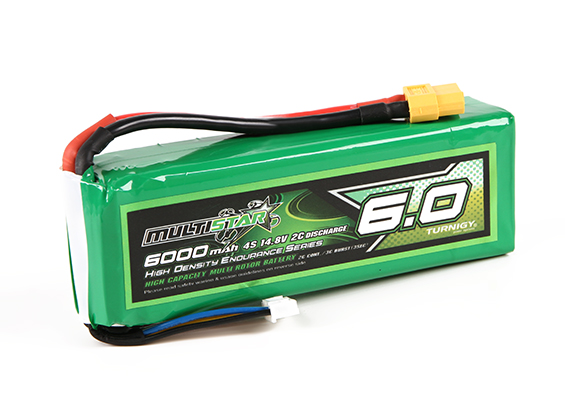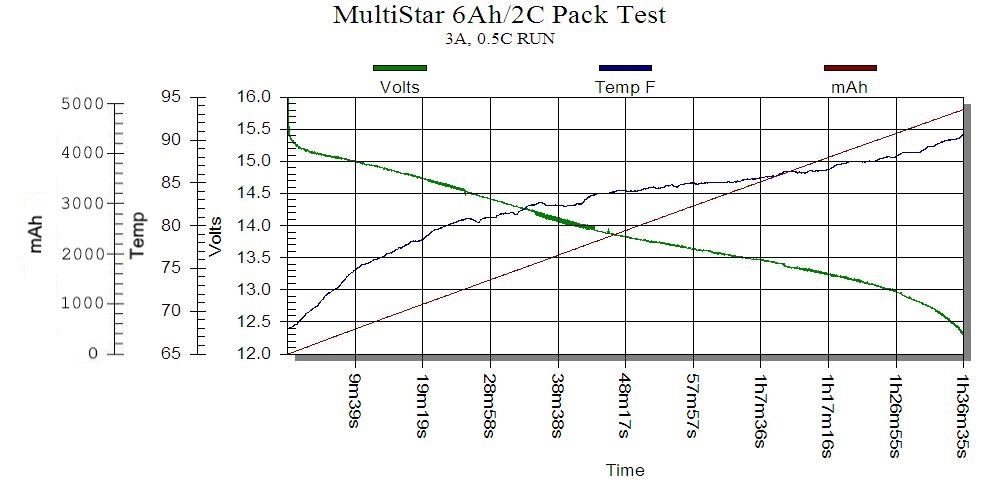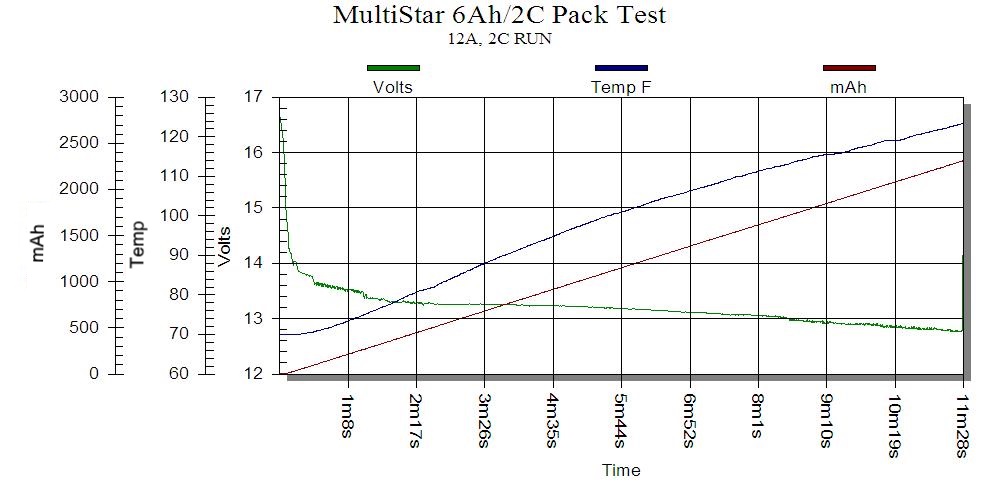Difference between revisions of "Multistar Lightweight 2C Pack Tests"
(→2C, 12A Tests) |
(→Conclusion) |
||
| (3 intermediate revisions by the same user not shown) | |||
| Line 1: | Line 1: | ||
| + | <i>January 2016</i><br> | ||
| + | <br> | ||
| + | {| cellspacing="1" cellpadding="1" width="95%" border="0" | ||
| + | |- | ||
| + | | align="left" valign="bottom" width="30%" | __TOC__ | ||
| + | | align="right" width="70%" | [[File:MS6A4S2C.jpg|700px]] | ||
| + | |- | ||
| + | | | ||
| + | | align="right" width="50%" | MultiStar Lightweight | ||
| + | |} | ||
== Introduction == | == Introduction == | ||
| Line 78: | Line 88: | ||
:mAh re-charge - 2410<br><br> | :mAh re-charge - 2410<br><br> | ||
| − | As you can see the pack got very hot in the short amount of time the test was run. I would definitely not label this a 2C "Continuous" pack as it will not survive many discharge cycles at this current and temperature.<br><br> | + | As you can see the pack got very hot in the short amount of time the test was run. 125F (52C) is the very upper limit of temperature when measuring the surface of the pack. At this temperature the core pack temp is closer to 150F (65C) which is well into where damage is occuring. I would definitely not label this a 2C "Continuous" pack as it will not survive many discharge cycles at this current and temperature.<br><br> |
{| border="0" cellspacing="1" cellpadding="1" width="800" align="center" | {| border="0" cellspacing="1" cellpadding="1" width="800" align="center" | ||
| Line 87: | Line 97: | ||
|} | |} | ||
<br> | <br> | ||
| + | |||
| + | == Conclusion == | ||
| + | |||
| + | I was impressed by the actual weight of the pack and the fact that at a low enough discharge rate you will get very close to the 248Wh/Kg. Unfortunately this discharge rate is near 0.5C or less so to use it in an RC application, you will need to parallel several packs together to get a usable continuous current.<br><br> | ||
| + | |||
| + | At 1C the pack doesn't get too hot but it does get warm, delivers lower voltage and 15% less capacity. At 2C, it simply won't last many cycles and the capacity is less than half of the 0.5C run. | ||
| + | <br><br><br> | ||
[[Category:Contents]] | [[Category:Contents]] | ||
Latest revision as of 23:24, 14 February 2016
January 2016

| |
| MultiStar Lightweight |
Introduction
Recently a fellow RCGroups poster pointed me to a new Multistar 6.0Ah/4S/2C pack with a claimed weight of 364g. Doing the math this means this pack has a power density of 244Wh/Kg which is considerably higher than any Hobby grade lipo I have seen or tested. Higher even than the hi-end Panasonic and LG 18650 industrial cells. My first reaction was that this was not very likely and that these numbers where likely marketing BS or simply an error. With that, I decided to buy and test one of these packs, to see for myself.
This then are the results of nine test runs. Three tests at 0.5C (3A), three at 1C (6A) and finally three at 12A (2C). All tests were done on the Medusa Power Analyzer Pro using a small motor and prop for load. The pack was set in open air on two edges of a small box with no active (fan) cooling. The pack was allowed to cool for 2 hours after each 3A and 6A test and 4 hours between each 12A test.
It should be noted that it is very rare that any hobby grade lipo pack lives up to their stated standard 'C' rating.
Measured Pack Dimensions
- Weight - 367g with all wires and connectors
- Width - 45mm
- Length - 135mm
- Height - 29mm
0.5C, 3A Tests
The first tests at 0.5C were run from a fully charged pack with each pack starting at room temperature. The tests were terminated at 12.4v (3.1v/cell) to keep from harming the pack. The specs shown below are from the third run and vary little from the first two tests.
- Constant load - 3A (+/-0.15)
- Start temperature - 68.0F (20C)
- End temperature - 90.7F (32.6C)
- ROA (Rise over ambient) - 22.7F (12.6C)
- Run time - 1h:36m:48s
- Starting voltage (unloaded) - 16.47v
- Ending voltage (loaded) - 12.37
- Rested voltage @ 15 min - 13.65v
- mAh consumed - 4919
- mAh re-charge - 4997
At 0.5C the temperature stays well within safe limits, the mAh consumed was fairly normal at 82%. At this discharge rate this battery should last a very long time.

|
| 3 amp run chart |
1C, 6A Tests
The second round of tests at 1C (6A) were set up the same as the 3A test with the exception of termination was at 12.8v (3.2v/cell) again, to keep from damaging the pack.
- Constant load - 6A (+/-0.15)
- Start temperature - 64.8F (18.2C)
- End temperature - 106.3F (41.3C)
- ROA - 41.5F (23.1C)
- Run time - 41m:40s
- Starting voltage (unloaded) - 16.54v
- Ending voltage (loaded) - 12.79
- Rested voltage @ 15 min - 14.07v
- mAh consumed - 4292
- mAh re-charge - 4347
The results of this test I would suggest that while 1C will run to the termination voltage without getting too hot, the ROA suggests that this is near the limit of continuous, safe discharge current.

|
| 6 amp run chart |
2C, 12A Tests
The last round of tests were short and hot! Termination was again at 12.8v (3.2v/cell).
- Constant load - 12A (+/-0.15)
- Start temperature - 69.9F (21.1C)
- End temperature - 123.6F (50.9C)
- ROA - 53.7F (29.8C)
- Run time - 11m:32s
- Starting voltage (unloaded) - 16.64v
- Ending voltage (loaded) - 12.77
- Rested voltage @ 15 min - 14.79v
- mAh consumed - 2312
- mAh re-charge - 2410
As you can see the pack got very hot in the short amount of time the test was run. 125F (52C) is the very upper limit of temperature when measuring the surface of the pack. At this temperature the core pack temp is closer to 150F (65C) which is well into where damage is occuring. I would definitely not label this a 2C "Continuous" pack as it will not survive many discharge cycles at this current and temperature.

|
| 12 amp run chart |
Conclusion
I was impressed by the actual weight of the pack and the fact that at a low enough discharge rate you will get very close to the 248Wh/Kg. Unfortunately this discharge rate is near 0.5C or less so to use it in an RC application, you will need to parallel several packs together to get a usable continuous current.
At 1C the pack doesn't get too hot but it does get warm, delivers lower voltage and 15% less capacity. At 2C, it simply won't last many cycles and the capacity is less than half of the 0.5C run.